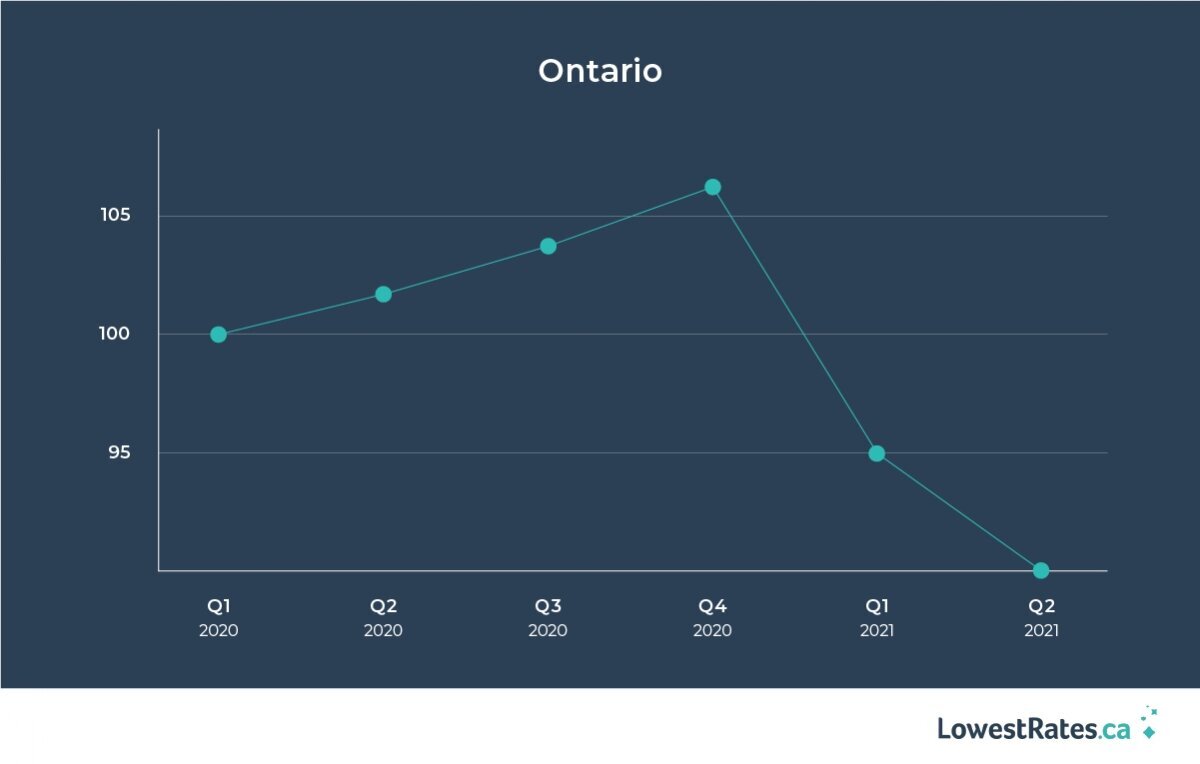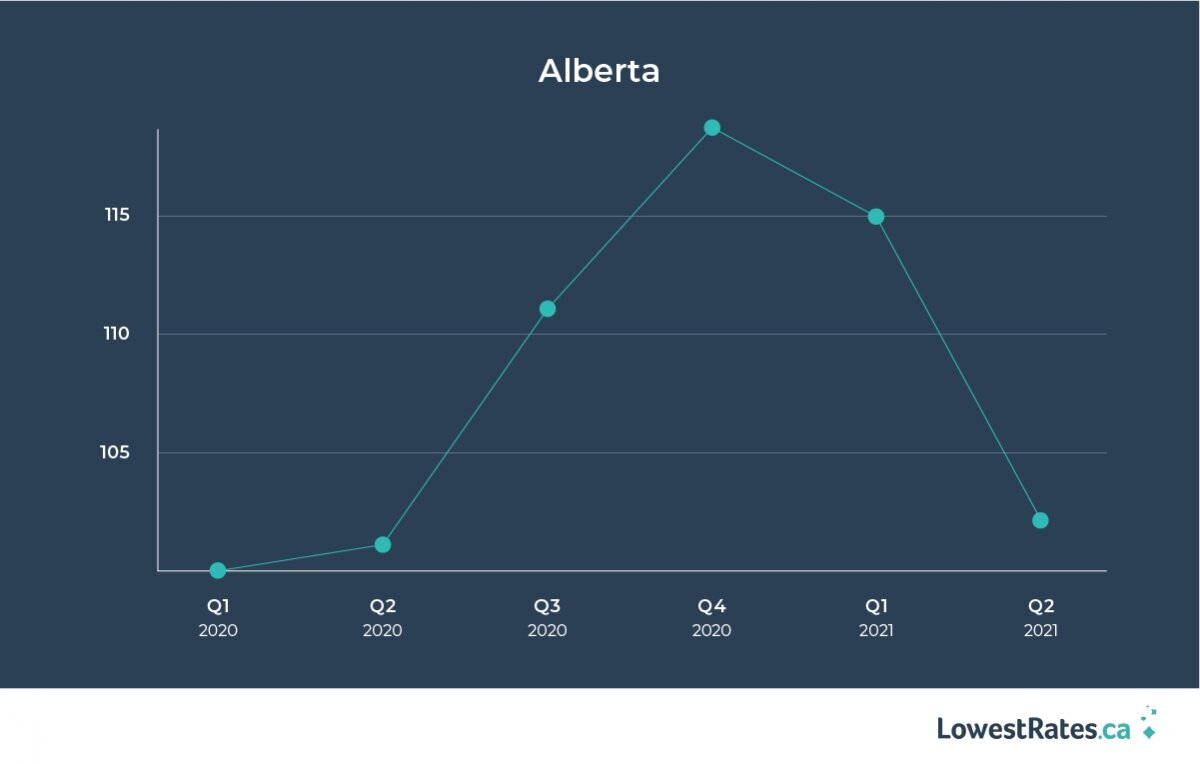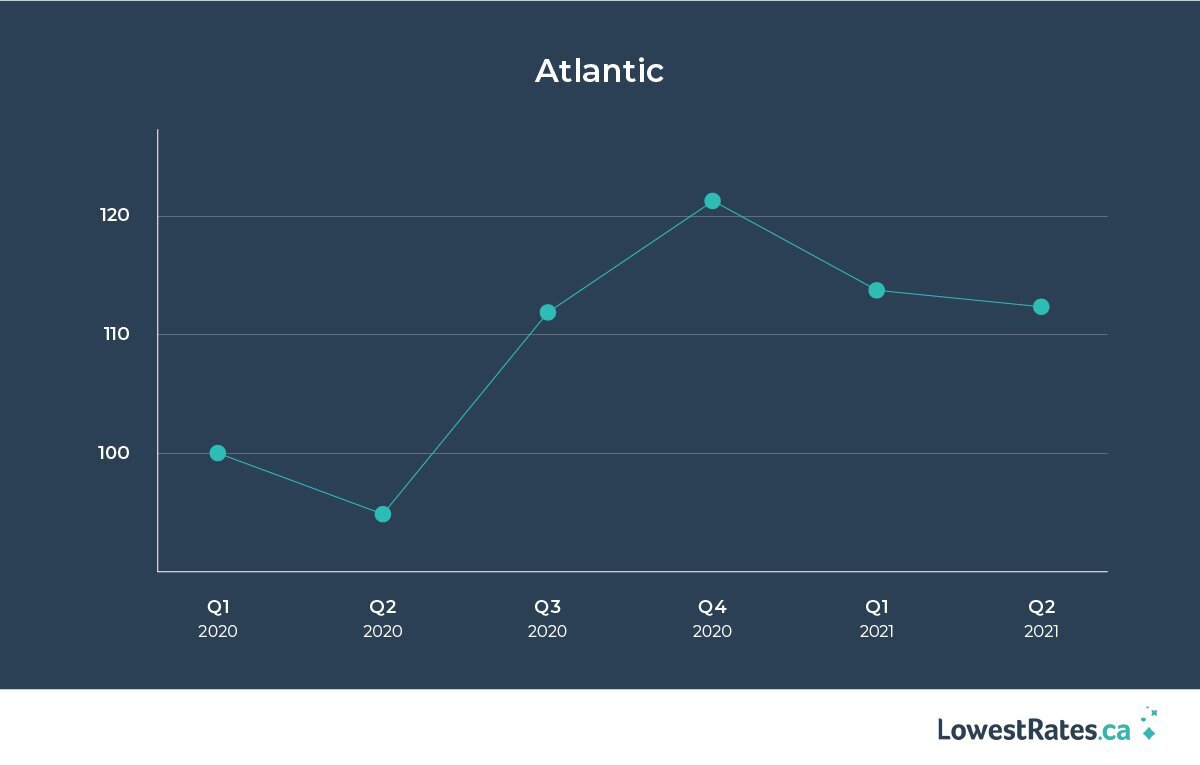REPORT: Auto insurance rates drop even lower in Q2 2021 as drivers keep cars parked
By: Alexandra Bosanac on October 6, 2021
Car insurance rates plunged in Ontario and Alberta this spring, while rates stayed flat in Atlantic Canada.
In our last report, we predicted that pandemic conditions would continue to drive down prices and our data bore that out.
Ontario was the poster child for market competition: many insurance providers re-entered the market, which helped drive prices down. By contrast, Alberta had fewer insurance companies to choose from, but rates still went down. Meanwhile, drivers Atlantic Canada have made fewer claims but insurance providers didn't pass on savings at the same rate
As the pandemic drags on, it's becoming clear that not everyone is benefiting equally from insurance companies' improved profitability.
Here are some key takeaways from our report:
- In Ontario, rates went down by 5% quarter-over-quarter, and 11% year-over-year.
- In Alberta, rates went down 11% quarter-over-quarter, but are up 1% year-over-year.
- In Atlantic Canada, rates are down by less than 1% and are up by almost 20% year- over-year.
The index is created from the hundreds of thousands of insurance quotes we get every year and shows whether prices in your province are rising or falling. Here’s how it works: Our baseline is set at 100. This means that if our index increases from 100 to 101, prices have increased by roughly 1%. (One thing to note: this index doesn’t factor in inflation.)
Next, how can the index help you find a cheaper car insurance policy?
If you currently have insurance, check to see how your renewal rate is comparable to the average increase/decrease listed on the index. Even if your rate matches the index, it may still be possible to find a lower rate, especially if you’ve recently celebrated a milestone birthday.
Being aware of the long-term trend of car insurance prices drives home the importance of shopping around for insurance.
Now, let’s look at the index and the change in the average car insurance rates by province.
Ontario

QoQ change: -4.8%
YoY change: -11.2%
Premium change (%) by age year-over-year
| Under 25 | -10.6% |
| Ages 25 to 49 | -13.2% |
| Ages 50+ | -18.3% |
Premium change (%) by gender year-over-year
| Female | -12.1% |
| Male | -11.3% |
Spring 2021 was a great time to shop for car insurance in Ontario. Auto insurance prices in the province fell for the second consecutive quarter on LowestRates.ca, down almost 5% compared to the previous quarter and a staggering 11% since the same time last year.
An influx of novice drivers (people with less than four years of driving experience) applied for insurance quotes through our site. Typically, search interest from this demographic would drive the average price up. But that's not what happened.
Instead, all of the insurance providers in our digital marketplace slashed their rates. With car insurance claims way down in 2021, insurance companies are more profitable than they’ve been in a long time. This means they’re eager to offer coverage to new customers.
According to data from MSA Research, an analytical research firm focused on the Canadian insurance industry, the ratio of losses versus expenses for Canadian insurance companies is 20% lower than what that the industry considers its ideal target — translated, it shows that insurance providers are beating their own expectations by a significant degree.
Why are car insurance companies suddenly so profitable? Thanks to the pandemic, the number of claims are down a whopping 23% quarter-over-quarter, according to MSA. This means insurance providers are keeping more money from each policy they write. It's no surprise then that we’ve seen many more insurance companies opting to be featured in our digital marketplace.
Our take is that premiums will keep going down as long as a critical mass of people continue to work from home.
Here’s how rates have changed across the GTA.
Toronto
QoQ: -1%
YoY: -8%
Brampton
QoQ: -7%
YoY: -15%
Hamilton
No change QoQ
YoY: -3%
Mississauga
QoQ: -5%
YoY: -12%
Kitchener
QoQ: -8%
YoY: -11%
London
QoQ: -5%
YoY: -7%
Alberta

QoQ change: -10.9%
YoY change: +0.9%
Premium change (%) by age year-over-year
| Under 25 | -10.7% |
| Ages 25 to 49 | +1.6% |
| Ages 50+ | -0.2% |
Premium change (%) by gender year-over-year
| Female | -0.2% |
| Male | +1.4% |
Car insurance prices dropped for the second consecutive quarter in Alberta, down 11% compared to the previous three months. However, prices are up by nearly 1% compared to the same time last year.
Unlike Ontario, there’s no clear-cut explanation for the rate reduction in Alberta.
The number of insurance providers actively looking to write new policies in the province is falling and, typically, prices would spike in this kind of environment. However, instead of jacking up rates for everyone, the remaining insurance providers showed an eagerness to scoop up new customers and to reduce rates across the board, especially for young drivers.
Year over year, drivers under 25 saw their rates fall by 10%. Meanwhile, the over-50 crowd — the demographic that insurance companies usually pass savings to first — saw their rates decrease by less than 1%.
Atlantic Canada

QoQ change: -0.5%
YoY change: +19.6%
Premium change (%) by age year-over-year
| Under 25 | +19.2% |
| Ages 25 to 49 | +17.8% |
| Ages 50+ | +12.5% |
Premium change (%) by gender year-over-year
| Female | +25.1% |
| Male | +17.5% |
Unfortunately, the favourable market conditions that drivers in Alberta and Ontario experienced didn’t reach consumers in Atlantic Canada.
A sizeable chunk of insurance providers reduced their presence on LowestRates.ca in the second quarter. That means drivers had fewer insurance options to choose from, which caused prices to stagnante.
It’s an indication that insurance companies don’t have a strong appetite to do business in the region. In insurance jargon, Atlantic Canada has a ‘hard market.’
However, Alberta is also facing similar supply issues. So why aren't insurance companies aren’t rewarding drivers in Atlantic Canada?
It could be due to drivers in Atlantic Canada having shorter commutes than those in Ontario and Alberta. In fact, when it comes to the percentage of people with commutes at least an hour long, the city of Oshawa alone beats the combined average of the entire Atlantic, according to the 2016 census.
Still, there have been fewer collisions in Canada since the pandemic began, so it’s surprising to see prices increase by almost 20% year-over-year.

.jpg?itok=88nBkwga)
.jpg?itok=W5fSKczJ)